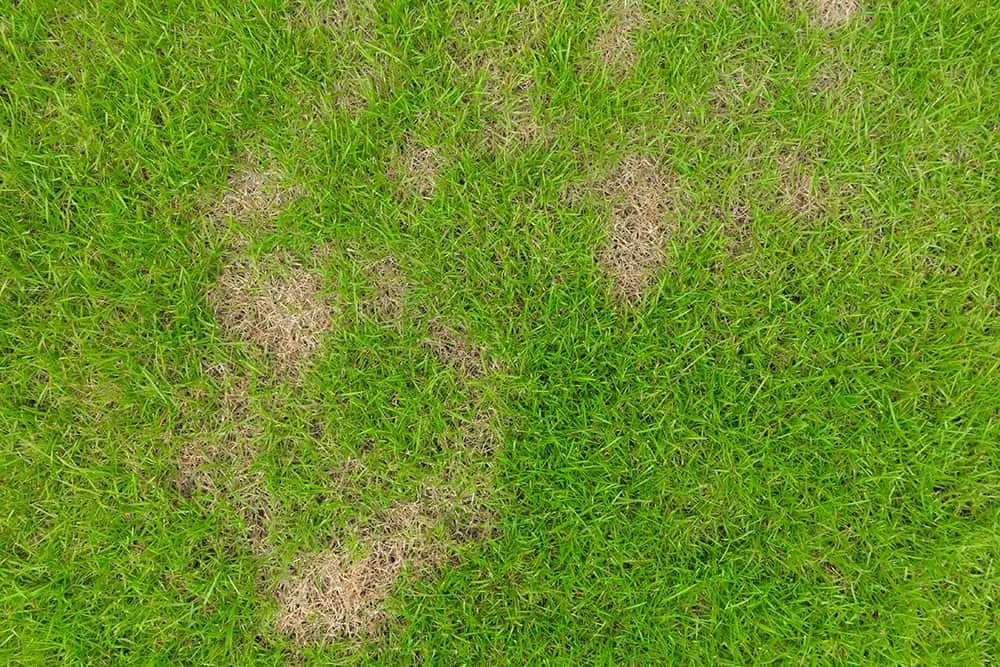Despite the comparatively pretty name for a destructive fungus, dollar spot can look extremely unappealing, especially if it spreads across a wide patch of once-luscious lawn.
Appearing as pale, wet spots in your turf, normally between 1-6 inches in diameter, they glint in the sun and loosely resemble silver dollars nestled amongst the grass. Unfortunately, it only takes a closer look to realize you’re not magically growing money.
Rather than the silver coloring connoted by the name, if you examine the infected blades, you’ll find them more of a sickly butter-yellow ringed with a darker sienna.

It starts in small spots on each blade and spreads until the full length is uniformly yellow. If you get up early in the day, you may even find delicate webs growing across the problem area.
Many mistake them for cobwebs after spider activity during the night, but this web is actually a fungal mycelium.
As spots collide during the spreading process, they can amass into huge irregular patterns that don’t look too appealing, but dollar spot isn’t actually the most damaging fungus.
Blighting the leaf tissue of turf, it leaves the roots and crowns completely unscathed. Even so, it’s an incredibly irritating and unsightly garden issue.
Another way to identify dollar spot is if the infected areas have sunken ever so slightly beneath the level of your healthy turf.
If you’ve got a dog, you’d be forgiven for giving them a stern talking to, as dollar spot looks exactly the same as when a pooch decides to pee on your lawn.
Dog urine has high levels of nitrogen, and when it’s unleashed as a concentrated stream onto a single spot, it can dry grass into a straw-colored mess.
It might only be after the dollar spot has spread quite viciously that you’ll realize you’ve been reprimanding your poor pooch for no reason at all.
If you do have a dog, and you’re unsure whether pale spots in your lawn are due to dollar spot or pee, look for the tell-tale sienna tinge. If the grass is just a dry yellow color, there’s a good chance your pup’s been peeing where they shouldn’t.
What Causes Dollar Spot
Dollar spot fungus occurs in high humidity, especially if there is a restricted airflow to the grass.
The fungus itself, schlerotinia homeocarpa, comes from the earth and is most prevalent from early spring right through to the backend of fall when daytime temperatures reach between 59-86°F (15-30°C), and the nights are cool.
The reason the temperature range for infection is so wide is that different biotypes of dollar spot are more notorious at different temperatures.
Turfs with a moist canopy and dry soil are the most susceptible to infection. Low nitrogen fertility in the earth is another reason your lawn might develop a dollar spot problem.
Dollar spot can be exacerbated greatly if areas of your lawn are covered, preventing sunlight and air from drying the buildups of dew on the blades. This excess moisture combined with the ambient humidity provides the perfect catalyst for fungal growth.
Not all grass types are equally at risk from dollar spot. Those particularly susceptible include bents, fine fescues, and annual meadow grass. If you have any of these grasses on your land, you should keep a close eye on them during the humid months.
The good news is that dollar spot doesn’t have its own reproductive process or autonomy. This means that it can’t spread on its own.
It requires mechanical help, by which we mean it must be physically moved from place to place through the dissemination of already infected plant matter.
There are both chemical and cultural management techniques that can prevent dollar spot infection. If you don’t fancy bringing chemicals into the mix, responsible irrigation practices may be all you need.
Irrigation should be done sparingly, and the moisture should penetrate the soil rather than sitting in the grass canopy.
Never water your lawn in the evening, as the moisture will stagnate and provide a favorable environment for dollar spot fungus to thrive.
Combine this irrigation technique with dew-reduction in the mornings and there’s very little chance your lawn will suffer infection. Dew reduction can be achieved by mowing, or dew-whipping your lawn with a long flexible pole.
Some simply run a length of rope across their lawn to shake off all those sparkling beads of dew.
You may also want to consider the play of shade in your garden throughout the day. If, for example, a tree blocks the sun in one area during most of the daylight hours, you may need to consider trimming it down.
If you do require chemical intervention, carboxamides, dicarboxamides, nitriles, demethylation inhibitors, and benzimidazoles are just a few of the substances that will get the job done.
